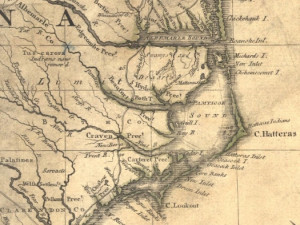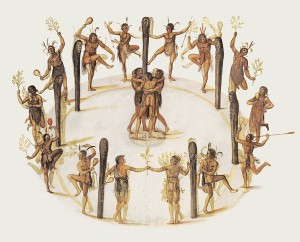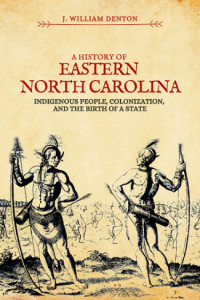William Denton discusses a major source of the culture clash between Algonquian people and the first Europeans in North Carolina.
###
 Relevant History welcomes William Denton: historian, author, and blogger. Born and raised in Eastern North Carolina, his areas of study include ancient and classical history, North Carolina history, education, and politics. William attended North Carolina State University, Liberty University, and Unicaf University, holds a BS in Religion, an MA in History, and a Ph.D. in Humanities. He is a member of the American Historical Association and the Association of Ancient Historians. His historical nonfiction, A History of Eastern North Carolina: Indigenous People, Colonization, and the Birth of a State, will be released next week on 28 October. William and his wife live in Nash County, North Carolina with their son. To learn more about him and his books, visit his web site.
Relevant History welcomes William Denton: historian, author, and blogger. Born and raised in Eastern North Carolina, his areas of study include ancient and classical history, North Carolina history, education, and politics. William attended North Carolina State University, Liberty University, and Unicaf University, holds a BS in Religion, an MA in History, and a Ph.D. in Humanities. He is a member of the American Historical Association and the Association of Ancient Historians. His historical nonfiction, A History of Eastern North Carolina: Indigenous People, Colonization, and the Birth of a State, will be released next week on 28 October. William and his wife live in Nash County, North Carolina with their son. To learn more about him and his books, visit his web site.
*****
 The coast of Eastern North Carolina was once home to an abundance of Algonquian tribes. The Iroquoian Tuscarora tribes were more influential within the Upper and Lower Inner Banks and Coastal Plain regions. These various Algonquian-speaking peoples occasionally formed loose affiliations and alliances, which, when paired with their overlapping cultural practices, sometimes blurred the lines of individual tribal identification.
The coast of Eastern North Carolina was once home to an abundance of Algonquian tribes. The Iroquoian Tuscarora tribes were more influential within the Upper and Lower Inner Banks and Coastal Plain regions. These various Algonquian-speaking peoples occasionally formed loose affiliations and alliances, which, when paired with their overlapping cultural practices, sometimes blurred the lines of individual tribal identification.
For example, the historical mentions of the Weapemeoc Nation can lead to some confusion, as the nation consisted of an association of subdivided tribes named the Pasquotank, Perquimans, and Poteskeet. The Weapemeoc were also often referred to as the Yeopim Indians, presumably from the English’s difficulty in pronouncing the tribe’s Algonquian name.
As English incursions into native territory increased, social disruptions created various cultural shifts within the local tribes, further complicating the issue of identity. One of the most interesting aspects of Algonquian culture, however, has to do with the role that women played in the political and social structure of the tribes.
The role of women in Algonquian villages
The Algonquian nations of Eastern North Carolina possessed a beautiful and well-preserved culture that differed from that of the Europeans in key aspects. Some native tribes in the area were matrilineal, meaning that familial relationships and organization were centered around the mother, as compared to the Western patrilineal culture wherein family lineage was reckoned along the father’s ancestral line.
One of the best examples of this is the case of Manteo’s mother, who was said to be a leader within Croatoan society before being inadvertently killed by English colonists during a confusing conflict between the Croatoan and Roanoke tribes.
Even in tribes without strict matrilineal practices, women wielded considerable power and influence within the native Carolina populations. In the family unit, individual homes were owned by women, with a man marrying into a woman’s home and joining her family. Clan names were often passed down through the mother, as opposed to the Western tradition of paternal surnames.
The matrilineal customs of the native peoples perplexed the European colonists, as they frequently attempted to deal with only the male members of tribes in matters of trade and diplomacy. Sometimes this confusion over internal tribal power structures led to treaties and land agreements being delayed or misunderstood as the English insisted on dealing only with the men from native settlements, even though some tribal leaders were female.
It would be inaccurate, however, to label these native tribes of Eastern North Carolina as matriarchal. Though influence often passed along maternal lines, men also exercised political influence and tribal control. Hunting and fishing rights passed from father to son, and many tribes recognized a paternal line of authority within their village.
The founding of many villages centered around a common male ancestor. Shamans were almost always men and had considerable influence over chiefs and elders. If anything, the native populations had relatively balanced gender roles, especially when compared to the European society of the time.
The village homes were owned by women who helped manage affairs within the village, including cultivating crops and gathering resources. Men hunted and protected the settlement. Both men and women contributed to governing their villages.
The communal nature of indigenous political organization
In matters of politics, the native tribes were characterized by communal leadership rather than a formal system of government. While chiefs led local villages within a tribe, the majority of decisions were made by mutual consent of a council of some sort, usually made up of elders and well-respected members of the tribe, though decisions were made in the best interests of the entire village.
 While the exact power structure varied from tribe-to-tribe, all Algonquian tribes shared common elements and traits. For example, unlike their Iroquoian counterparts, the Algonquians did not form strong alliances or political bonds with other Algonquian tribes, though they did collectively respond to military threats at times. The Algonquians were more interested in village-based relationships, with many clans who claimed a common ancestry gathering together in a local settlement.
While the exact power structure varied from tribe-to-tribe, all Algonquian tribes shared common elements and traits. For example, unlike their Iroquoian counterparts, the Algonquians did not form strong alliances or political bonds with other Algonquian tribes, though they did collectively respond to military threats at times. The Algonquians were more interested in village-based relationships, with many clans who claimed a common ancestry gathering together in a local settlement.
The Algonquian tribes of Eastern North Carolina held time-honored customs and beliefs that predated the arrival of Europeans by centuries, if not millennia. As the English colonists began to expand into Native territory and establish trade relationships with the various tribes, the native populations began to suffer irreparable harm.
Disease, warfare, slavery, land theft, and the disruptive nature of the colonists’ technological advancements quickly reduced the Carolina Natives’ populations within a century of initial contact with the Europeans. Their cultures were also forever changed, with many tribes assimilating into the newly encountered European way of life and disappearing from the pages of history. The important role that women played in the social structure of the Algonquian people, however, is one historical element that must not be forgotten.
*****
 A big thanks to William Denton! He’ll give away a copy of A History of Eastern North Carolina to someone who contributes a comment on my blog this week. I’ll choose the winner from among those who comment by Friday at 6 p.m. ET. Delivery is available within the U.S. only.
A big thanks to William Denton! He’ll give away a copy of A History of Eastern North Carolina to someone who contributes a comment on my blog this week. I’ll choose the winner from among those who comment by Friday at 6 p.m. ET. Delivery is available within the U.S. only.
**********
Did you like what you read? Learn about downloads, discounts, and special offers from Relevant History authors and Suzanne Adair. Join Suzanne Adair’s Patreon, and subscribe to her free newsletter.

Interesting stuff! I’m reading When God Was a Woman, which goes into older matrilineal cultures. Thanks for the essay!
Thanks Kaye! It’s definitely a subject that doesn’t get the attention that it deserves, even among fellow historians.
When God was a Woman is classic, Kaye. Next have a look at The Chalice and the Blade by Riane Eisler. Latest research makes some of that material outdated. I look forward to seeing where this research is going next. I’m currently studying some of the classics on the Sumerians, and as more cuneiform tablets are translated, some of that “classic” info gets outdated, too.
Thanks, Suzanne. I’m amazed I discovered When God Was a Woman so late!
suzanneadair, interesting that you bring that up. My original training is in ancient Near East history. I’m currently helping with the global effort to translate Sumerian and Akkadian cuneiform tablets. There are only a few of us who read it and the task is daunting, though it is starting to move along.
I have a Sumerian backstory in my (unpublished) science fiction series and would enjoy talking with you more sometime about the Black-Headed People. My hat’s off to you, sir, for being patient enough to learn to read cuneiform. I’d wondered who’d picked up the baton after Dr. Kramer moved along to the Great Ziggurat.
suzanneadair, I wrote my master’s thesis on Sargon the Great, the development of his legendarium, and his uniting the ung sang gig-ga (Black-Headed-People) into the Akkadian Empire. The Sumerian and Akkadians are some of my favorite people to study.
I am very interested in William Denton’s work. I live in Bath, which has it’s own history linked to the Tuscarora Indian War, and I have ancestors that settled on Slade’s Creek in Hyde County around 1702. One member of this family of Tison’s may have been killed during the war in 1711. I have deep roots in the early colonization of North Carolina.
Thanks for the interest, Mary! My book has an entire section dedicated to the Tuscarora War, especially its impact on Bath, the death of John Lawson, etc. As someone who also has deep roots in Eastern NC, I’d be happy to share my research findings with you!
Very interesting research! Though it may be changing, the citizens of Eastern North Carina have not paid enough attention to the earliest inhabitants of our region.
Thanks Elizabeth! I concur. We have done a poor job of educating the people of NC on the history and culture of the native peoples of this land. During the course of my research, however, I have discovered that there is a renewed interest in the subject. I hope it continues to grow.
Pingback: The Matrilineal Culture of the Algonquian Peoples of Eastern North Carolina | Author Suzanne Adair – Green Dragon, Artist and Author
This is wonderful, thank you, William and Suzanne!
I live in Tyrrell County, and probably the most prominent Native-related “thing” we have is subsidized housing called Secota Village. I don’t even know how many citizens of the county actually realize that the Secotans are the namesake of the little neighborhood. Tyrrell students get to hear a bit of Native history at nearby Pettigrew Park’s Indian Heritage Week, but other than that, sadly, very little is known about the area’s indigenous people.
Thanks, Susan! I agree. I cover the history of the Secotan in my book. They were an important people during the early days of colonization in North Carolina and one of the most powerful indigenous groups in the Coastal NC area prior to European colonization. John White’s watercolors of Secotan villages still exist. Much of what we know about the broader Algonquian people group of NC comes from the Secotan.
That’s just incredible to learn! I need to hit up the library to see if they’ve added your book to the NC shelves!
Enjoyed reading the article and everyones comments. I love history. I found it especially intriguing to read about the translation of the cuneiform tablets.
I’m from St. Joseph Missouri, founded by Joseph Robidoux, fur trader. Home of the Pony Express and where Jesse James died.
Thanks Susan!
I was once asked to write a story about an interesting, powerful Native American woman whose name and authority had been handed down for generations. As an Anglo, I definitely did not have the platform to do this since most of the history I found was from European sources. This essay verifies that I made the right decision to turn down the request. Thanks for the insights.
My 7th great grandfather, Reverend Grindal Rawson 1659-1715) was a Puritan minister in Mendon, MA. He is recognized for learning the Algonquian language in 9 months and venturing out to hold religious services for the Wampum Indians. I am very interested in the book about North Carolina
Linda, that’s fascinating! Very few non-indigenous people took the time to learn the Algonquian language after Thomas Harriot translated Carolina Algonquian. Thanks for sharing!
Interesting.
Recently saw https://www.archaeology.org/news/8105-191014-japan-female-shaman about possible female shaman.
This is so interesting!! It makes you realize how much people have not changed, thinking their way is always the only way.
Spot-on, Danielle. First contact stories in science fiction make great use of human nature: our tendency to fit the “other” into the box we know of ourselves.
Indeed, Danielle. It’s amazing to see how much humanity has changed in some aspects and how we have failed to do so in other key areas.
Thank you for sharing all this, William and Suzanne. In my own research on the Shawnee, which shared some of the same Algonquin language, I found them to have a fairer balance of male and female input—so very different from all we learned in basic high school history classes to be sure. Did you find the Algonquin also shared the sense of humor and teasing the Shawnee were often described as having? That was just one aspect too seldom portrayed historically.
Karen, the Shawnee are particularly interesting in that while they had kings, the lines of succession were matrilineal. The sons in a particular female line had preeminence. A king’s sons didn’t automatically become king upon his death. It’s amazing how different gender roles were in native tradition.